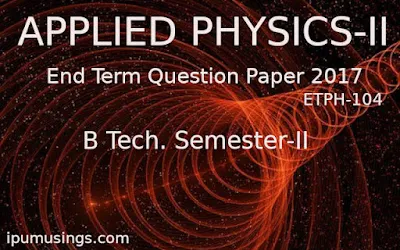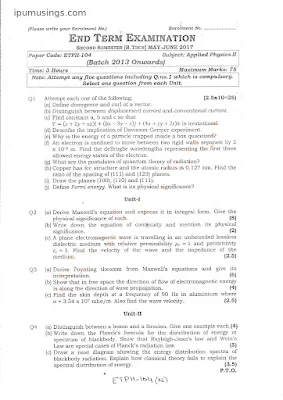BTech Sem-2 - Applied Physics - II - End Term Examination Question Paper 2017 #appliedphysics2 #ipumusings #physicspaper
BTech Sem-2 - Applied Physics - II - End Term Examination Question Paper 2017 Paper Code: ETPH-104
Applied Physics - II Btech Sem-2 - Question Paper 2017
Q1: Attempt each one of the following: (2.5 x10=25)
(a) Define divergence and curl of a vector.
(b) Distinguish between displacement current and conventional current.
(c) Find constant a, b and c so that
V = (e+ 2y t.az)i + (bx — 3y —2)j + (4x + cy + 22)k is irrotational.
(d) Describe the implication of the Davisson-Germer experiment.
(e) Why is the energy of a particle trapped inside a box quantized?
(f) An electron is confined to move between two rigid walls separate by 2 x 10⁻⁹m. Find the de Broglie wavelengths representing the first three allowed energy states of the electron.
(g) What are the postulates of the quantum theory of radiation?
(h) Copper has fcc structure and the atomic radius is 0.127 nm. Find the ratio of the spacing of (111) and (123) planes.
(i) Draw the planes (100), (110) and (111).
(j) Define Fermi energy. What is its physical significance?
Unit - I
Q2: (a) Derive Maxwell’s equation and express it in integral form. Give the physical significance of each. (8)
(b) Write down the equation of continuity and mention its physical significance. (2)
(c) A plane electromagnetic wave is travelling in an unbounded lossless dielectric medium with relative permeability μr = 1 and permittivity εR=3. Find the velocity of the wave and the impedance of the medium, (2.5)
Q3: (a) Derive Poynting theorem from Maxwell’s equations and give its interpretation. (6)
(b) Show that in free space the direction of the flow of electromagnetic energy is along the direction of wave propagation. (4)
(c) Find the skin depth at a frequency of 90 Hz in aluminium where ρ = 3.54 x 10⁷ mho/m. Also, find the wave velocity. (2.5)
Unit-II
Q4: (a) Distinguish between a boson and a fermion. Give one example each. (4)
(b) Write down Planck’s formula for the distribution of energy in the spectrum of a blackbody. Show that Rayleigh-Jean’s law and Wein’s Law are special cases of Planck’s radiation law. (5)
(c) Draw a neat diagram showing the energy distribution spectra of blackbody radiation. Explain how classical theory fails to explain the spectral distribution of energy. (3.5)
Q5: (a) Derive Schrodinger time-dependent wave equation for non-relativistic particle. Give the physical interpretation of Hamilton operator, H. (6)
(b) State the properties of the wave function in a quantum mechanical system. Give one example each for an acceptable and non-acceptable wave function. (4)
(c) An electron has a speed of 2 x 10⁴ m/s within the accuracy of 0.01%, Calculate the uncertainty in the position of the electron. (2.5)
Unit-III
Q6: (a) What do you understand by packing factor in crystals? Calculate the packing factor in the case of bec and fcc lattices. (4.5)
(b) What do you mean by a lattice constant? Obtain a relation between the lattice constant of a cubic crystal and the density of the crystal material. (4)
(c) Define Miller indices. If a, b, and C are the primitive vectors of the unit cell a plane of Miller indices (310) cut the crystal lattice, find the intercepts of the plane along the three axes. (4)
Q7: (a) What are Schottky and Frenkel defects? Obtain an expression for the concentration of Schottky defects in a crystal. (6)
(b) Why do we use X-rays to study crystal diffraction? Is it possible to observe diffraction pattern if radiation of wavelength 2 x 10⁻⁶ m is incident on a crystal with interplanar separation of 10⁻⁸ cm? Justify. (4)
(c) Lead has an fcc structure and its body diagonal is 0.86 nm. When X-rays of wavelength 0.71A undergoes diffraction from the (110) plane to produce second-order maxima, calculate the glancing angle. (2.5)
Unit IV
Q8: (a) What are Brillouin zones? How are they related to the energy levels of an electron in a metal? (4)
(b) Define the effective mass of an electron. Obtain an expression for the effective mass of an electron moving in a periodic potential. (5)
(c) Where does Fermi level lie in an n-type semiconductor? Discuss the effect of temperature and doping concentration on the position of the Fermi level in an n-type semiconductor. (3.5)
Q9: (a) What is the Hall effect? Derive an expression for the Hall coefficient. Explain how the measurement of the Hall coefficient helps to determine the mobility of electrons in metals. (7)
(b) The Hall voltage for the metal sodium is 0.001 mV, measured. at I = 100mA, B = 2 Wb/m² and width of the specimen is 0.05 mm. Calculate the number of carriers per cubic meter in sodium. (3)
(c) Distinguish between intrinsic and extrinsic semiconductors. (2.5)






